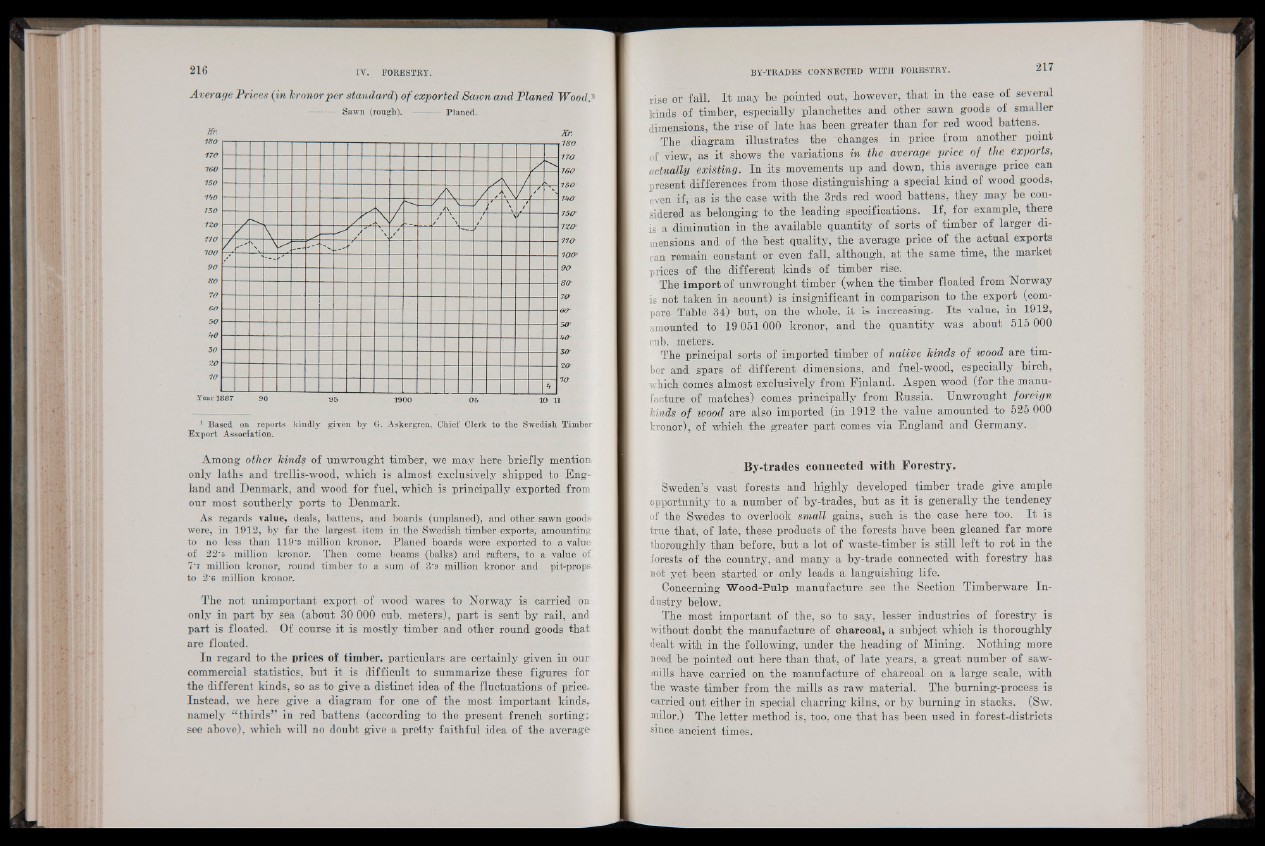
1 verage Prices (in kronor p er standard) of exported Sawn and Planed Wood*
Sawn (rough). --------- Planed.
Hr. Xr.
1 Based on reports kindly given by G-. Askergren, Chief Clerk to the Swedish Timber
Export Association.
Among other kinds of unwrought timber, we may here briefly mention
only laths and trellis-wood, which is almost exclusively shipped to England
and Denmark, and wood for fuel, which is principally exported from
our most southerly ports to Denmark.
As regards value, deals, battens, and boards (unplaned), and other sawn goods-
were, in 1912, by far the largest item in the Swedish timber exports; amounting
to no less than 119'3 million kronor. Planed boards were exported to a value
of 22‘5 million kronor. Then come beams (balks) and rafters, to a value of
7'7 million kronor, round timber to a sum of 3‘9 million kronor and pit-props
to 2'6 million kronor.
The not unimportant export of wood wares to Norway is carried on
only in part by sea (about 30 000 cub. meters), part is sent by rail, and
part is floated. Of course it is mostly timber and other round goods that
are floated.
In regard to the prices of timber, particulars are certainly given in our
commercial statistics, but it is difficult to summarize these figures for
the different kinds, so as to give a distinct idea of the fluctuations of price.
Instead, we here give a diagram for one of the most important kinds,
namely “thirds’’ in red battens (according to the present french sorting;
see above), which will no doubt give a pretty faithful idea of the average
rise or fall. It may be pointed out, however, that in the case of several
kinds of timber, especially planchettes and other sawn goods of smaller
dimensions, the rise of late has been greater than for red wood battens.
The diagram illustrates the changes in price from another point
of view, as it' shows the variations in the average price of the exports,
actually existing. In its movements up and down, this average price can
present differences from those distinguishing a special kind of wood goods,
even if,-as is the case with the 3rds red wood battens, they may be considered
as belonging to the leading specifications. If, for example, there
is a diminution in the available quantity of sorts of timber of larger dimensions
and of the best quality, the average price of the actual exports
can remain constant or even fall, although, at the same time, the market
prices of the different kinds of timber rise.
The import of unwrought timber (when the timber floated from Norway
is not taken in acount) is insignificant in comparison to the export (compare
Table 34) but, on the whole, it is increasing. Its value, in 1912,
amounted to 19 051 000 kronor, and the quantity was about 515 000
cub. meters.
The principal sorts of imported timber of native kinds of wood are timber
and spars of different dimensions, and fuel-wood, especially birch,
which comes almost exclusively from Finland. Aspen wood (for the manufacture
of matches) comes principally from Russia. Unwrought foreign
kinds of wood are also imported (in 1912 the value amounted to 525 000
kronor), of which the greater part comes via England and Germany.
By-trades connected with Forestry.
Sweden’s vast forests and highly developed timber trade give ample
opportunity to a number of by-trades, but as it is generally the tendency
of the Swedes to overlook small gains, such is the case here too. I t is
true that, of late, these products of the forests have been gleaned far more
thoroughly than before, but a lot of waste-timber is still left to rot in the
forests of the country, and many a by-trade connected with forestry has
not yet been started or only leads a languishing life.
Concerning Wood-Pulp manufacture see the Section Timberware Industry
below.
The most important of the, so to say, lesser industries of forestry is
without doubt the manufacture of charcoal, a subject which is thoroughly
dealt with in the following, under the heading of Mining. Nothing more
need be pointed out here than that, of late years, a great number of sawmills
have carried on the manufacture of charcoal on a large scale, with
the waste timber from the mills as raw material. The burning-process is
carried out either in special charring kilns, or by burning in stacks. (Sw.
milor.) The letter method is, too, one that has been used in forest-districts
since ancient times.